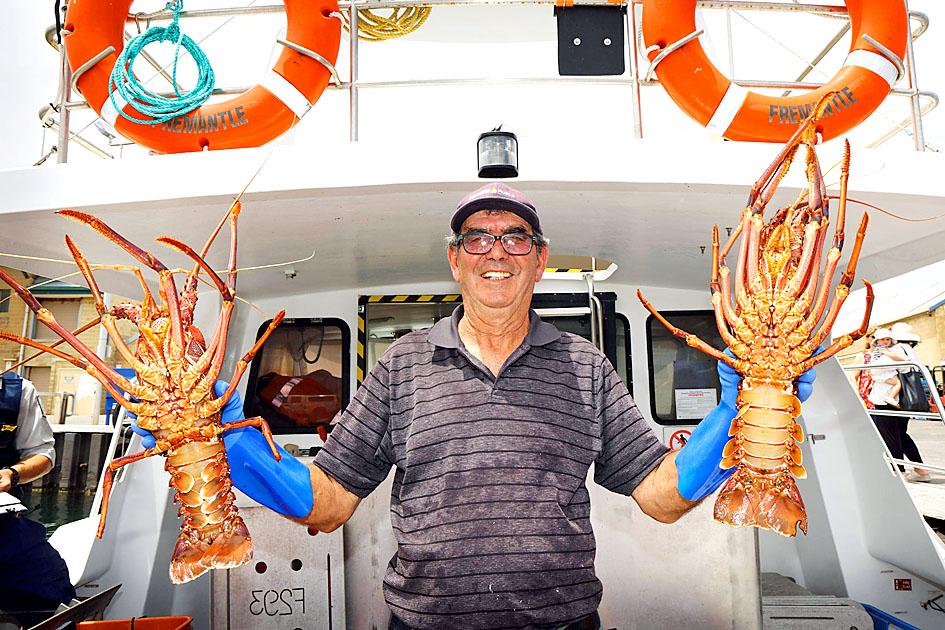Australia’s rock lobsters — a long-prized delicacy among Chinese consumers — might be finding their way onto mainland menus through a backdoor that circumvents a worsening diplomatic and trading dispute between the two nations.
Since direct shipments to China virtually ground to a halt in November last year, Hong Kong has become the world’s largest importer of Australian lobsters, with monthly trade growing more than 2,000 percent from October last year to April.
While lower prices will have spurred some increased demand from Hong Kong consumers, experts say the dramatic spike is more likely due to a gray trade as the tasty crustaceans are sent across the border to the mainland.

Photo: AFP
“It’s highly unlikely that locked-down Hong Kong citizens are suddenly buying, cooking and eating 20 times more lobster in their homes over the last six months,” said Deborah Elms, the Singapore-based executive director of the Asian Trade Centre. “Lobster is a high-value product. As with any high-value product, the incentives to skirt the rules are also high.”
Customs clearance delays and increased inspections for lobsters, which are typically flown in on ice to be consumed within 72 hours or put into holding tanks, saw plane loads of exports perishing on the airport tarmac late last year. Australian officials, who investigated complaints of heavy metal traces in two shipments and reported back to Chinese authorities in December, are still awaiting a response.
Lobsters are the latest in a string of Australian exports to be caught up in the widening spat between Canberra and Beijing, after Australian Prime Minister Scott Morrison’s government led calls for an independent inquiry into the origins of COVID-19.
China accounted for 93 percent of Australian lobster exports of A$544 million (US$413 million) in 2019-2020, according to official government statistics compiled by the Canberra-based Fisheries Research and Development Corp (FRDC).
Lobster, which translates to dragon shrimp in Chinese, is viewed as a symbol of prosperity due to its auspicious name and vibrant red hue. Often steamed and presented with its shell intact at celebratory banquets, Australian rock lobsters are famous for their fine yet firm texture, salty tang and sweet aftertaste, retailing at a price two to three times that of Maine lobsters before China’s unofficial ban.
The trade has slumped by 99 percent in the first four months of this year compared with a year earlier.
Meanwhile, the value of Australian lobster exports to Hong Kong in April was A$25 million — the highest monthly total since February 2013, FRDC data showed. The total for the first four months of the year was A$78.1 million, more than triple the value for the whole of last year.
It is unlikely they have all stayed within the territory.
China’s fish and crustaceans imports from Hong Kong jumped from US$500,247 in September last year to US$10.6 million in April, Chinese customs data showed.
On Baidu’s wholesaling platform, multiple suppliers continue to offer Australian lobsters. JD.com (京東), one of China’s leading e-commerce sites, currently displays live Australian lobsters selling at about 1,500 yuan (US$232) each, some with same-day delivery for Guangdong.

CHIP RACE: Three years of overbroad export controls drove foreign competitors to pursue their own AI chips, and ‘cost US taxpayers billions of dollars,’ Nvidia said China has figured out the US strategy for allowing it to buy Nvidia Corp’s H200s and is rejecting the artificial intelligence (AI) chip in favor of domestically developed semiconductors, White House AI adviser David Sacks said, citing news reports. US President Donald Trump on Monday said that he would allow shipments of Nvidia’s H200 chips to China, part of an administration effort backed by Sacks to challenge Chinese tech champions such as Huawei Technologies Co (華為) by bringing US competition to their home market. On Friday, Sacks signaled that he was uncertain about whether that approach would work. “They’re rejecting our chips,” Sacks

NATIONAL SECURITY: Intel’s testing of ACM tools despite US government control ‘highlights egregious gaps in US technology protection policies,’ a former official said Chipmaker Intel Corp has tested chipmaking tools this year from a toolmaker with deep roots in China and two overseas units that were targeted by US sanctions, according to two sources with direct knowledge of the matter. Intel, which fended off calls for its CEO’s resignation from US President Donald Trump in August over his alleged ties to China, got the tools from ACM Research Inc, a Fremont, California-based producer of chipmaking equipment. Two of ACM’s units, based in Shanghai and South Korea, were among a number of firms barred last year from receiving US technology over claims they have

BARRIERS: Gudeng’s chairman said it was unlikely that the US could replicate Taiwan’s science parks in Arizona, given its strict immigration policies and cultural differences Gudeng Precision Industrial Co (家登), which supplies wafer pods to the world’s major semiconductor firms, yesterday said it is in no rush to set up production in the US due to high costs. The company supplies its customers through a warehouse in Arizona jointly operated by TSS Holdings Ltd (德鑫控股), a joint holding of Gudeng and 17 Taiwanese firms in the semiconductor supply chain, including specialty plastic compounds producer Nytex Composites Co (耐特) and automated material handling system supplier Symtek Automation Asia Co (迅得). While the company has long been exploring the feasibility of setting up production in the US to address

OPTION: Uber said it could provide higher pay for batch trips, if incentives for batching is not removed entirely, as the latter would force it to pass on the costs to consumers Uber Technologies Inc yesterday warned that proposed restrictions on batching orders and minimum wages could prompt a NT$20 delivery fee increase in Taiwan, as lower efficiency would drive up costs. Uber CEO Dara Khosrowshahi made the remarks yesterday during his visit to Taiwan. He is on a multileg trip to the region, which includes stops in South Korea and Japan. His visit coincided the release last month of the Ministry of Labor’s draft bill on the delivery sector, which aims to safeguard delivery workers’ rights and improve their welfare. The ministry set the minimum pay for local food delivery drivers at